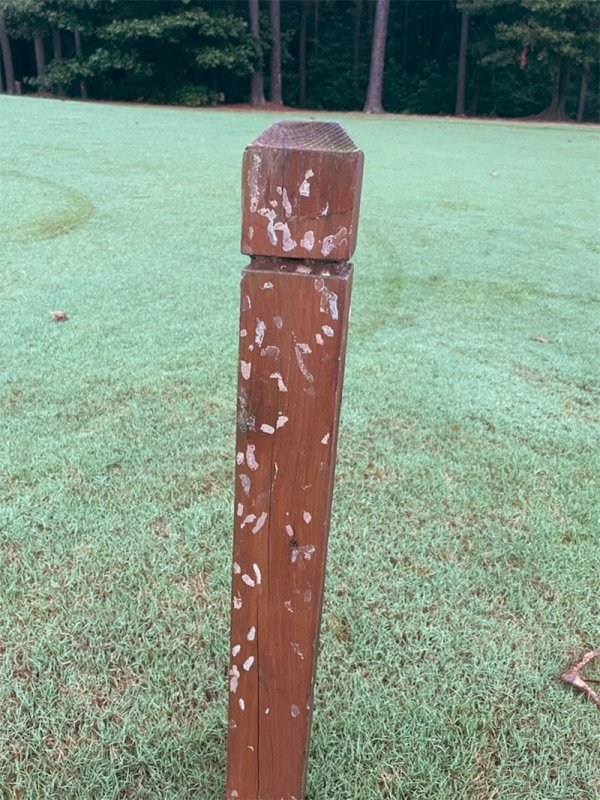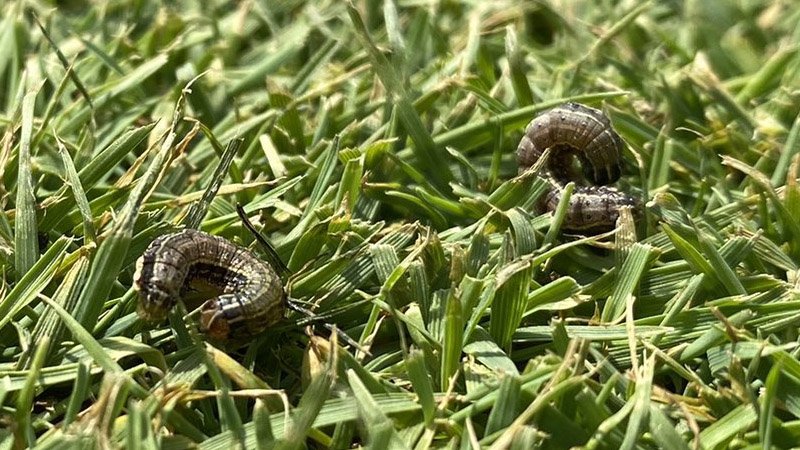By now, everyone has seen the widespread damage being caused this summer by fall armyworms, either in person or in a photo posted to social media by some other unlucky soul. Wide swaths of brown turf attributed to the voracious appetite of this inch-and-a-half-long pest are common from Texas and Florida, northward to Canada and almost everywhere in between.
The far-reaching damage has left many turf managers with a couple of questions: How do I get rid of them? Will they return in similar numbers next year?
 University entomologists have plenty of advice on how to kill the pests, but are not so confident when discussing future activity. In fact, when it comes to predicting fall armyworm activity for the following year, Rick Brandenburg, Ph.D., admits there are many more questions than answers.
University entomologists have plenty of advice on how to kill the pests, but are not so confident when discussing future activity. In fact, when it comes to predicting fall armyworm activity for the following year, Rick Brandenburg, Ph.D., admits there are many more questions than answers.
"I've thought about why armyworms are so numerous this year, and I've been asked about that a lot," said Brandenburg, professor of entomology at North Carolina State University. "When you look back at spring and summer, it was different everywhere, so conditions were not consistent. It was a perfect storm for armyworm damage, but what does that perfect storm look like?
"We don't know a lot about their migration patterns. We might see them in May and June, or June and July. It just varies. The earlier we see them, the more serious the damage. But then, that's not always the case. There are a lot of factors, and things are so sporadic. We don't get a chance to study them year-over-year in the same location, and that's why we have a lot of questions. I'm glad I don't know more about them than I do, or my phone would never stop ringing."
What Brandenburg and his colleagues do know is that damage from fall armyworms is rarely permanent and likely is not a sign of things to come in subsequent years.
Fall armyworms cannot overwinter in freezing temperatures. They are native to southern Texas and Florida, but the adult moths catch a wind to migrate hundreds of miles to other areas each year. Once the moths land, they lay egg masses, each containing 300-500 eggs (as shown on the photo above by Rick Brandenburg), typically on overhangs and objects over turf. When the eggs hatch, thousands of caterpillars will drop onto the turf surface and begin feeding.
CLICK HERE FOR MORE INFORMATION ON ARMYWORM CONTROL
FROM TERRI BILLEISEN, PH.D. OF NORTH CAROLINA STATE UNIVERSITY
"We see them here in North Carolina every year. It's rare when someone in North Carolina doesn't get hit with them," Brandenburg said.
"They really love hybrid Bermuda. We see them every year, but I haven't seen them like I am this year. I haven't seen them like this in 30 years."
Armyworms do not just pop out of the egg on an eating binge. They have to grow into the role, said Dave Shetlar, Ph.D., professor emeritus at Ohio State. Armworms have been wiping out large areas on lawns, sports fields and golf courses for several weeks.
Shetlar said in a recent OSU Turf Team video that he has been inundated with emails from people saying their lawns, athletic fields and putting greens have "suddenly disappeared."
"No, they didn't suddenly disappear," Shetlar said as he pointed to a photograph of an armyworm that has been dining outside the Ohio Turfgrass Foundation Research Center at Ohio State.
"This caterpillar looks like a fifth instar. That caterpillar has probably been there for three weeks. And the problem is when they are in the first, second and third instar, they're little tiny caterpillars, and you don't see very much from them. When they get into that fourth, fifth and sixth instar, they're big, fat and sassy. A sixth instar caterpillar can eat probably 100 times more food per day than that little first and second instar."

Although fall armyworms regularly migrate out of their native area, massive outbreaks like the one on display this year occur only every five to seven years in areas in a northern climate. The moths can hitch a ride on upper-level winds and can even get swept up from the Gulf rim in a hurricane or tropical storm, like Hurricane Elsa, which made landfall in North Florida on July 6 then spawned nearly 20 tornadoes during the next three days through the Southeast then up the East Coast before re-entering the Atlantic off Newfoundland. The timing of the aligns perfectly with this year's armyworm outbreak, Shetlar said.
"In high-speed winds, they can be blown 500 miles in 24 hours," Shetlar said.
CLICK HERE FOR MORE INFORMATION ON ARMYWORM CONTROL
FROM DAVE SHETLAR, PH.D. OF OHIO STATE UNIVERSITY
Although armyworms and cutworms look rather similar, the former are much harder to kill - when they get fat and sassy.
Shetlar suggests several chemistries for effective control of fall armyworms. Pyrethroids offer a quick curative solution. Diamides are effective preventive options. Some also can be used for curative control, but also can be expensive.
We don't get a chance to study them year-over-year in the same location, and that's why we have a lot of questions. I'm glad I don't know more about them than I do, or my phone would never stop ringing.
Thanks to slightly cooler temperatures north of the transition zone, many courses in the Midwest and Northeast already are reporting recovery just days after experiencing near devastation.
"Turf will recover from fall armyworm damage," Brandenburg said. "If you have good fertility, good temperatures and good moisture, it will recover."
One of the questions Brandenburg often faces is whether outbreaks like this year are an indicator of what is to come in the future.
"I don't think it does," he said. "I think it's a new start every year.
"But, if warm-season turf doesn't have time to recover heading into winter, it is going to struggle. For example, if warm-season turf gets hammered in September, then it gets cool in October, it is going to have a hard time recovering, and if it hasn't recovered before the first frost, then it is going to struggle coming out of spring."

